FY2019 Annual Report
Quantum Systems Unit
Professor Thomas Busch
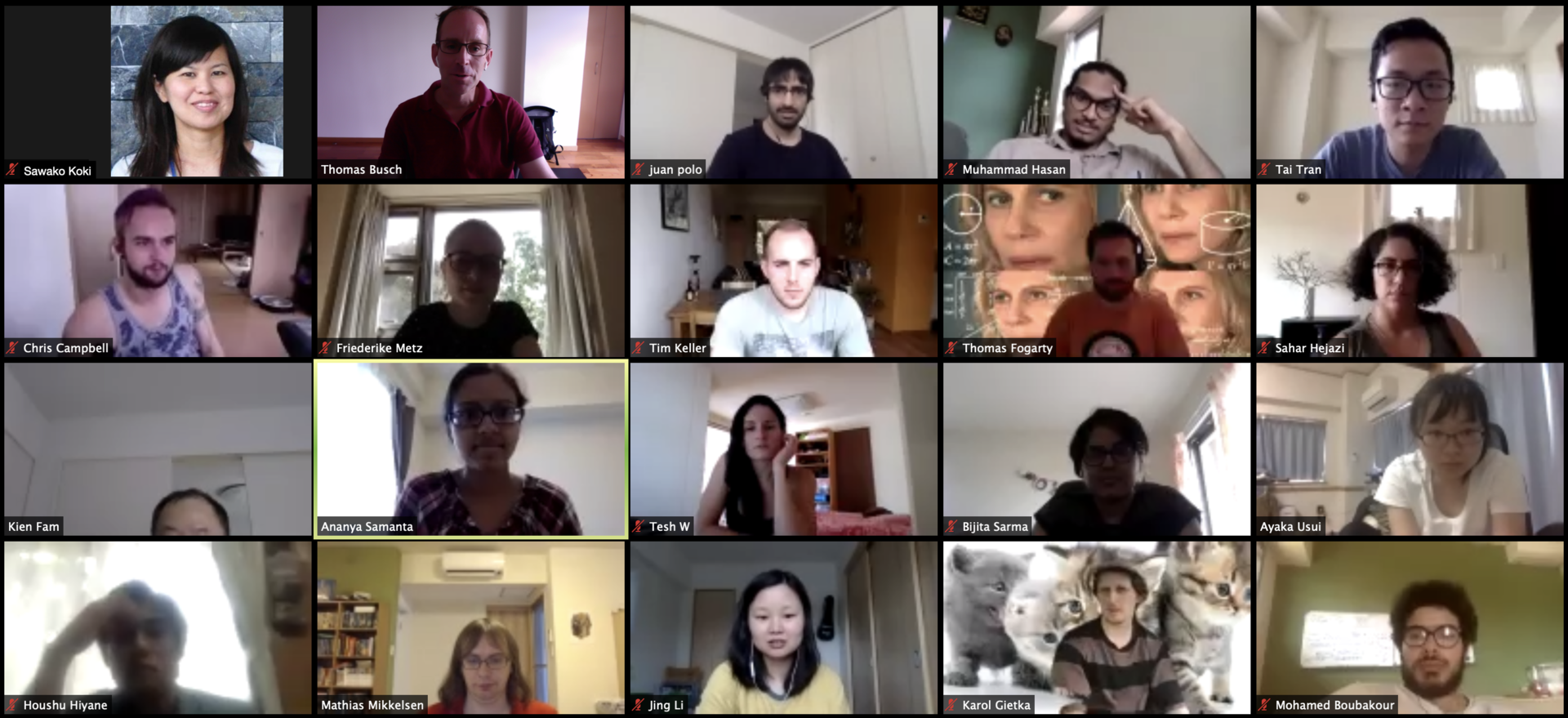
In the past year we have focused on the description of quantum thermodynamics properties in strongly correlated atomic systems, spin-orbit coupling in interacting systems, impurity dynamics in ultracold quantum gases, properties of atoms close to optical nano-fibers and several other topics.
1. Staff
- Dr. Thomás Fogarty, Postdoctoral Scholar
- Dr. Pham Le Kien, Staff Scientist
- Dr. Jing Li, Postdoctoral Scholar
- Dr. Bijita Sarma, Postdoctoral Scholar
- Dr. Karol Gietka, JSPS Research Fellow
- Dr. Irina Reshodko, Junior Research Fellow
- Mr. Jiabao Chen, PhD Student
- Mr. James Schloss, PhD Student
- Mr. Mathias Mikkelsen, PhD Student
- Ms. Seyedeh Sahar Seyed Hejazi, PhD Student
- Ms. Ayaka Usui, PhD Student
- Mr. Christopher Campbell, PhD Student
- Mr. Tim Keller, PhD Student
- Ms. Friederike Metz, PhD Student
- Mr. Lewis Ruks, PhD Student
- Ms. Leilee Chojnacki, PhD Student
- Mr. Muhammad Sirajul Hasan, PhD Student
- Ms. Sawako Koki, Research Unit Administrator
Rotation Students
- Mr. Mohamed Amine Boubakour (May-August, 2019)
- Ms. Keerthy Menon (September - December, 2019)
- Mr. Jose Carlos Pelayo (September-December, 2019)
- Mr. Teh Soon (September-December, 2019)
- Ms. Ananya Samanta (January-April, 2020)
Research Interns
- Ms. Sheilla de Oliveira Margues, University of Minas Greais (UFMG), Brazil (Jan 07 - Jul 05, 2019)
- Mr. Daniel Wong, University of Waterloo, Canata (Feb 01 -Jun 28, 2019)
- Ms. Jia Zhang, Shanghai University, China (Apr 09 - June 07, 2019)
- Ms. Rui Wang, Shanghai University, China (Apr 09 - June 07, 2019)
- Mr. Aikaterini Gratsea, University of Crete, Greece (May 23 - Oct 17, 2019)
- Mr. Benjamin Chislett, Memorial University of Newfoundland, Canada (June 30 - Aug 30, 2019)
- Mr. Houshu Hiyane, Tokyo University of Science, Japan *graduated (July 01 - Dec 27, 2019 / Feb 03 - Apr 30, 2020)
- Ms. Irina Korshok, Saint Petersburg State University, Russia *graduated (Oct 03, 2019 - Apr 30, 2020)
- Mr. Jianqiao Deng, The University of Hong Kong, China (Mar 25, 2019 - Aug 14, 2020)
2. Collaborations
2.1 Quantum thermodynamics
- Type of collaboration: Joint research
- Researchers:
- Prof. S. Campbell, University College Dublin, Ireland
- Prof. J. Goold. Trinity College Dublin, Ireland
2.2 Spin-orbit coupling in strongly correlated gases
- Type of collaboration: Joint research
- Researchers:
- Prof. S. Gardiner, Durham University, UK
2.3 Shortcuts to adiabaticity
- Type of collaboration: Joint research
- Researchers:
- Dr. A. Ruschhaupt, University College Cork, Ireland
- Prof. Xi Chen, Shanghai University, China
2.4 Cold atoms and optical nanofibers
- Type of collaboration: Joint research
- Researchers:
- Prof. Sile Nic Chormaic, OIST Graduate University, Japan
2.5 Nonlinear optomechanics
- Type of collaboration: Joint research
- Researchers:
- Prof. Jason Twamley, Macquarie University, Sydney, Australia
2.6 Impurities in strongly correlated quantum gases
- Type of collaboration: Joint research
- Researchers:
- Prof. P. Schmelcher, Hamburg University, Germany
- Prof. P. Schmelcher, Hamburg University, Germany
3. Activities and Findings
3.1 Quench Dynamics and Orthogonality Catastrophe of Bose Polarons
In collaboration with the group of Prof. Schmelcher at Hamburg University in Germany we have investigated the correlated quench induced dynamical dressing of a spinor impurity repulsively interacting with a Bose-Einstein condensate. Inspecting the temporal evolution of the structure factor, three distinct dynamical regions were found upon increasing the interspecies interaction. These regions are related to the segregated nature of the impurity and to the Ohmic character of the bath. We were able to show that the impurity dynamics can be described by an effective potential that deforms from a harmonic to a double-well one when crossing the miscibility-immiscibility threshold. We further illustrate that for increasing interaction an orthogonality catastrophe occurs and the polaron picture breaks down. In that case a dissipative motion of the impurity takes place leading to a transfer of energy to its environment. This process signals the presence of entanglement in the many-body system.
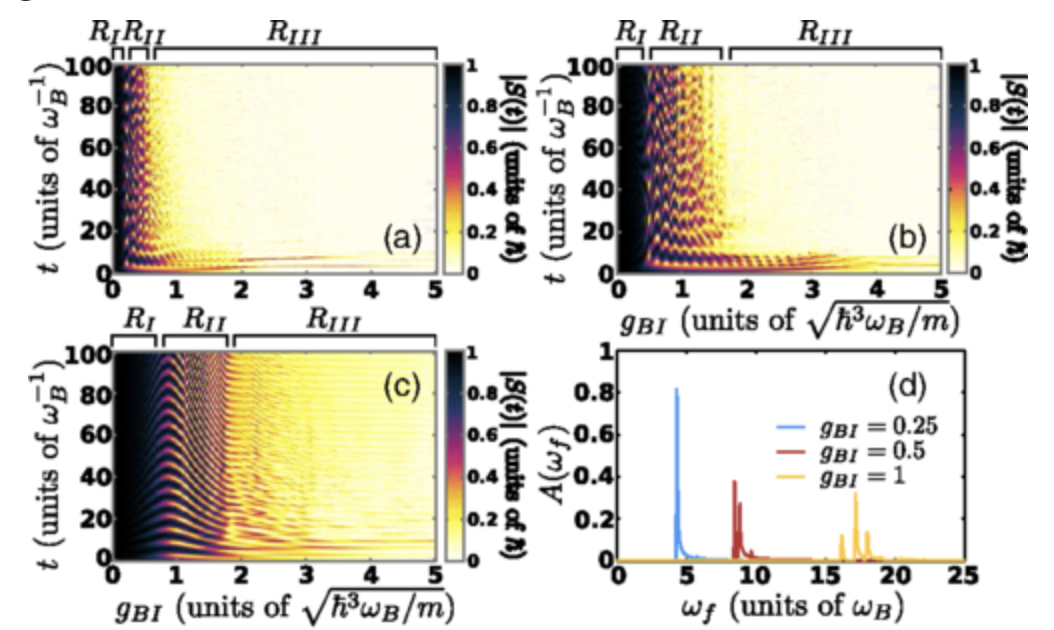
Figure: Evolution of the contrast upon increasing the interaction between a single impurity and the background for (a) a weakly interacting background and (b) a more strongly interacting background consisting of 100 particles. (c) same as (b) but for a background gas of 10 particles. (d) Excitation spectrum of the system indicating the emergent polaronic peaks.
3.2 Chaotic few-body vortex dynamics in rotating Bose-Einstein condensates
We have investigate a small vortex-lattice system of four corotating vortices in an atomic Bose-Einstein condensate and found that the vortex dynamics display chaotic behavior after a system quench introduced by reversing the direction of circulation of a single vortex through a phase-imprinting process. By tracking the vortex trajectories and Lyapunov exponent, we have shown that the onset of chaotic dynamics is not immediate, but occurs at later times and is accelerated by the close approach and separation of all vortices in a scattering event. The techniques we have developed could potentially be applied to create locally induced chaotic dynamics in larger lattice systems as a stepping stone to study the role of chaotic events in turbulent vortex dynamics.

Figure: Histograms of the positions of each vortex in the x-y plane, tracked over an evolution time of 20 s in the corotating frame. The vortex in the lower left has been annihilated by phase imprinting and reimprinted with (a) the same and (b) the opposite direction of rotation, exactly on the vortex core. (a) For four vortices with the same circulation direction, regular trajectories at constant radius appear, while in panel (b), disordered vortex trajectories can be seen.
3.3 Torque of guided light on an atom near an optical nanofiber
We analytically and numerically calculated the axial orbital and spin torques of guided light on a two-level atom near an optical nanofiber. From this we were able to show that the generation of these torques is governed by the angular momentum conservation law in the Minkowski formulation. The orbital torque on the atom near the fiber has a contribution from the average recoil of spontaneously emitted photons and photon angular momentum and atomic spin angular momentum can be converted into atomic orbital angular momentum. The orbital and spin angular momenta of the guided field are not transferred separately to the orbital and spin angular momenta of the atom.
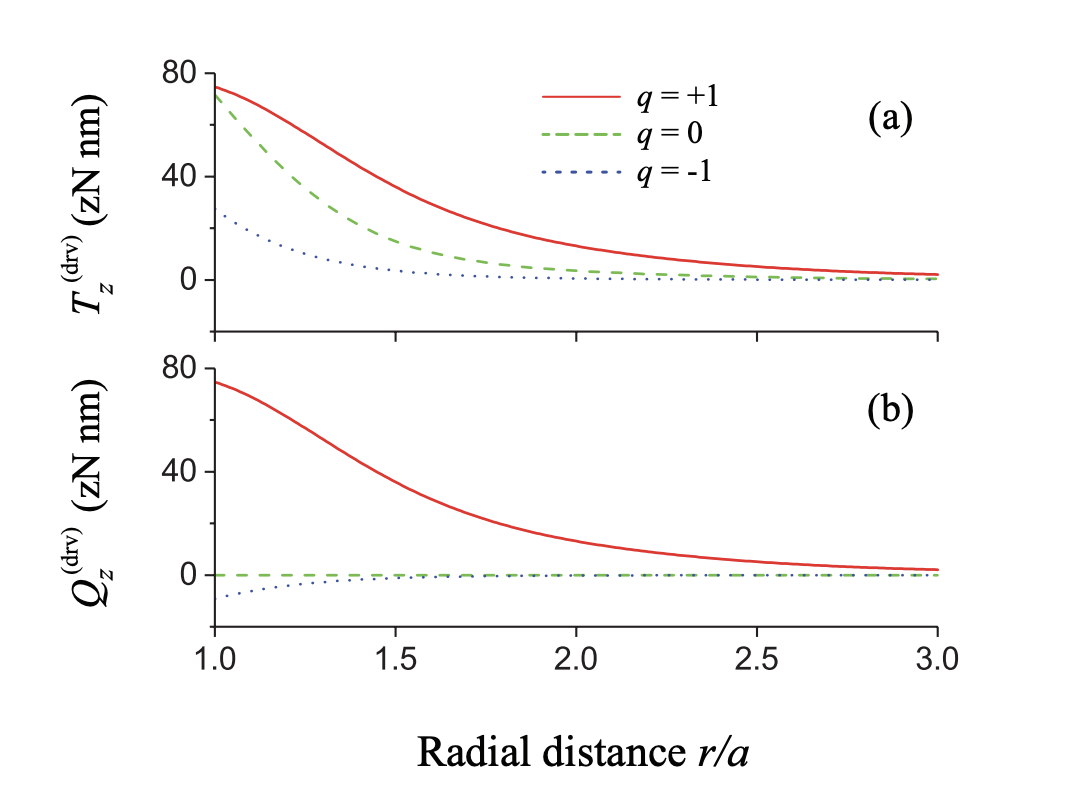
Figure: Radial dependencies of the (a) orbital and (b) spin torques of the guided driving field on the atom being at rest and in the steady state. The dipole matrix-element vector d has only one nonzero spherical tensor component dq, where q = 1, 0, and −1. The driving field is in a quasicircularly polarized HE21 mode. All other parameters are given in the publication.
Publication:
Torque of guided light on an atom near an optical nanofiber
F. Le Kien and Th. Busch
Opt. Exp. 27, 15046 (2019).
3.4 Driving Interactions Efficiently in a Composite Few-Body System
We have studied how to efficiently control an interacting few-body system consisting of three harmonically trapped bosons. Specifically, we have investigated the process of modulating the inter-particle interactions to drive an initially non-interacting state to a strongly interacting one, which is an eigenstate of a chosen Hamiltonian. For unbalanced subsystems, where one can individually control the different inter- and intra-species interactions, we have found complex dynamics originating from when the symmetry of the ground state was broken by phase separation. Since the driving the dynamics too quickly can result in unwanted excitations of the final state, we have also optimized the driven processes using shortcuts to adiabaticity, which are designed to reduce these excitations at the end of the interaction ramp, ensuring that the target eigenstate is reached.

Figure: Target one-body density matrices represented by white contour lines on top of final ones for three identical particles. Panels (a–c) correspond to the shortcut protocol, while panels (d–f) correspond to the reference pulse. Panels (a) and (d) are for a final interaction strength of gf = 1, (b) and (e) for gf = 5, and (c) and (f) for gf = 40.
3.5 Waveguide-induced dispersion interaction between two two-level atoms with orthogonal in-transverse-plane dipoles
We have studied the dispersive Casimir-Polder interaction potential between two ground-state two-level atoms near a cylindrical vacuum-clad optical waveguide in the case where the electric-dipole matrix-element vectors of the atoms are perpendicular to each other and to the interatomic axis. When these atoms are in free space, the potential between them vanishes. However, in the presence of a waveguide aligned parallel to the interatomic axis, the energy of the interaction potential between the atoms may become nonzero and comparable to the average potential energy between two atoms with arbitrarily oriented dipoles in free space. In addition, we found that the interaction potential between two atoms next to a gold-nano rod can be significantly enhanced compared to free space. Our results can have applications in manipulating and measuring the Casimir-Polder interaction between ground state atoms, molecules, and particles using nanoscale waveguides.
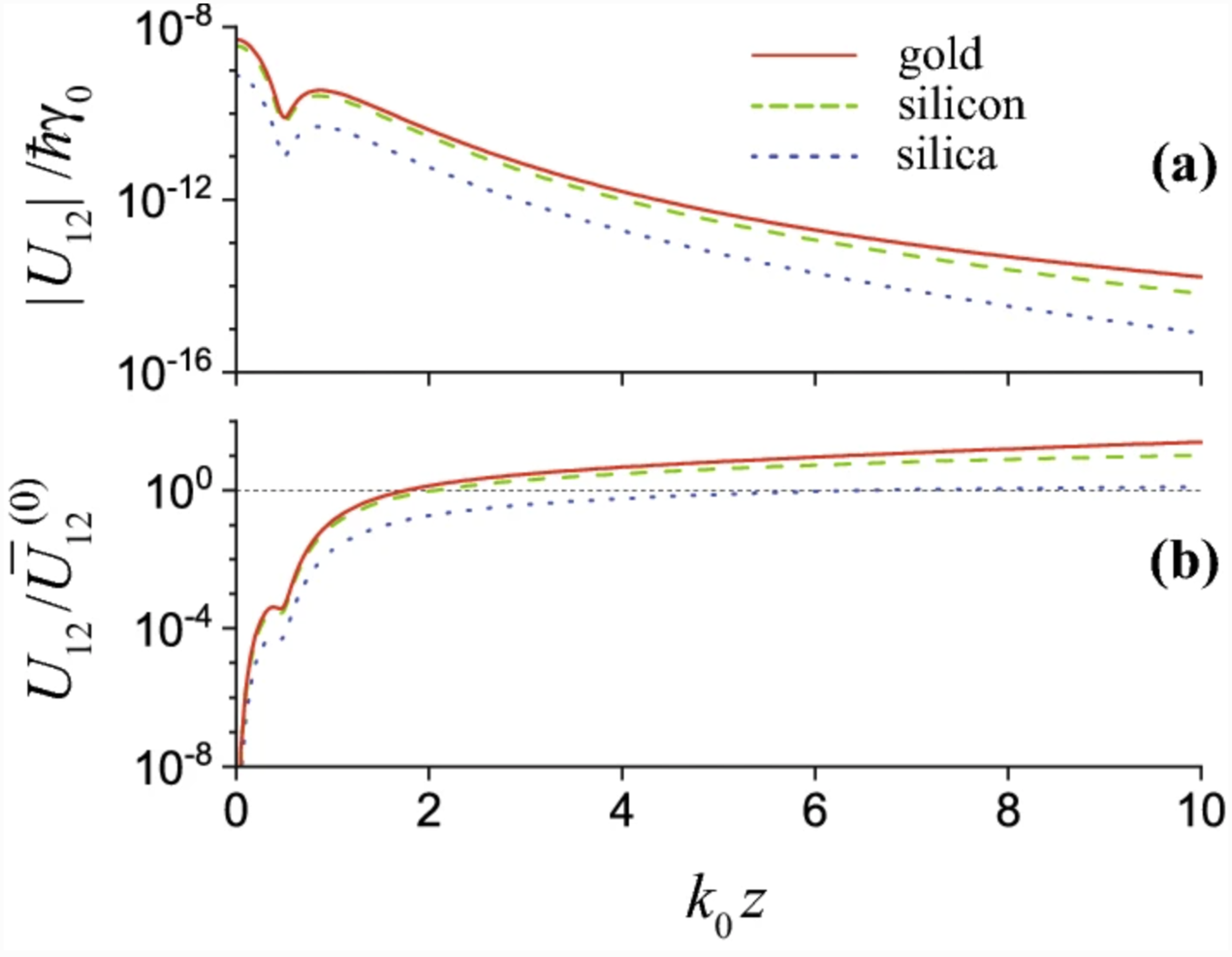
Figure: Normalised absolute value of the waveguide-mediated dispersion potential (a) and ratio with the the dipole-orientation-averaged vacuum dispersion potential (b) as a function of the distance between the atoms near an infinitely long cylinder made of gold (solid red lines), silicon (dashed green lines), and silica (dotted blue lines).
3.6 Graded-index optical fiber emulator of an interacting three-atom system: illumination control of particle statistics and classical non-separability
A system of three trapped ultracold and strongly interacting atoms in one-dimension can be emulated using an optical fiber with a graded-index profile and thin metallic slabs. While the wave-nature of single quantum particles leads to direct and well known analogies with classical optics, for interacting many-particle systems with unrestricted statistics such analoga are not straightforward. Here we have studied the symmetries present in the fiber eigenstates by using discrete group theory and shown that, by spatially modulating the incident field, one can select the atomic statistics, i.e., emulate a system of three bosons, fermions or two bosons or fermions plus an additional distinguishable particle. We have also shown that the optical system is able to produce classical non-separability resembling that found in the analogous atomic system.

Figure: : Schematic of the system. (a) Three interacting atoms in a one-dimensional harmonic trap. (b) Representation of the refractive index in the x-y plane. (c) Schematic of the fiber.
3.7 Spin-orbit coupling in the presence of strong atomic correlations
In collaboration with Dr. S. Campbell at University College Dublin and Prof. S. Gardiner at Joint Quantum Centre (JQC) Durham-Newcastle, we have explored the influence of contact interactions on a synthetically spin-orbit coupled system of two ultracold trapped atoms. Even though the system we have considered is bosonic, we were able to show that a regime exists in which the competition between the contact and spin-orbit interactions results in the emergence of a ground state that contains a significant contribution from a anti-symmetric spin state. This ground state is unique to few-particle systems and does not exist in the mean-field regime. The transition to this state is signalled by an inversion in the average momentum from being dominated by centre-of-mass momentum to relative momentum and also affects the global entanglement shared between the real- and pseudo-spin spaces. Indeed, competition between the interactions can also result in avoided crossings in the ground state which further enhances these correlations. However, we find that correlations shared between the pseudo-spin states are strongly suppressed due to the spin-orbit coupling and therefore the system does not contain spin-spin entanglement.

\(\)\(\) \(\) \(\)\(\) \(\) \(\) \(\)
Figure: Population of each pseudo-spin state of the ground state for (a) weak interactions and (b) strong interactions. The insets show the population of the symmetric state (red line) and the anyti-symmetric state (pink dotted line) using the left axis and the interaction energy (black dashed line) using the right axis. (c) Population differenceof the ground state as a function of spin-orbit coupling stength and intercomponent interaction strength. Only positive values, where the anti-aligned states dominate, are shown.
3.8 Many-body quantum dynamics and induced correlations of Bose polarons
Together with the group of Prof. P. Schmelcher from Hamburg University we have studied the ground state properties and non-equilibrium dynamics of two spinor bosonic impurities immersed in a one-dimensional bosonic gas upon applying an interspecies interaction quench. For the ground state of two non-interacting impurities we have revealed signatures of attractive induced interactions in both cases of attractive or repulsive interspecies interactions, while a weak impurity–impurity repulsion forces the impurities to stay apart. Turning to the quench dynamics we have inspected the time-evolution of the contrast unveiling the existence, dynamical deformation and the orthogonality catastrophe of Bose polarons. We have found that for an increasing postquench repulsion the impurities reside in a superposition of two distinct two-body configurations while at strong repulsions their corresponding two-body correlation patterns show a spatially delocalized behavior evincing the involvement of higher excited states. For attractive interspecies couplings, the impurities exhibit a tendency to localize at the origin and remarkably for strong attractions they experience a mutual attraction on the two-body level that is imprinted as a density hump on the bosonic bath.

Figure: Relative distance between the two bosonic impurities residing in the same pseudospin state for varying bath pseudospin interaction strength. The cases of two non-interacting, weakly interacting impurities as well as few and many bath particles are shown (see legend) for a mass-balanced system. The relative distance obtained from the effective potential picture given in eq. (9) in the publication for two non-interacting bosonic impurities is also shown (see legend). The inset shows the distance between two non-interacting impurities in the case of a mass-balanced and a mass-imbalanced system.
3.9 Orthogonality Catastrophe as a Consequence of the Quantum Speed Limit
A remarkable feature of quantum many-body systems is the orthogonality catastrophe that describes their extensively growing sensitivity to local perturbations and plays an important role in condensed matter physics. In this work we have shown that the dynamics of the orthogonality catastrophe can be fully characterized by the quantum speed limit and, more specifically, that any quenched quantum many-body system, whose variance in ground state energy scales with the system size, exhibits the orthogonality catastrophe. Our rigorous findings have been demonstrated by two paradigmatic classes of many-body systems - the trapped Fermi gas and the long-range interacting Lipkin-Meshkov-Glick spin model.
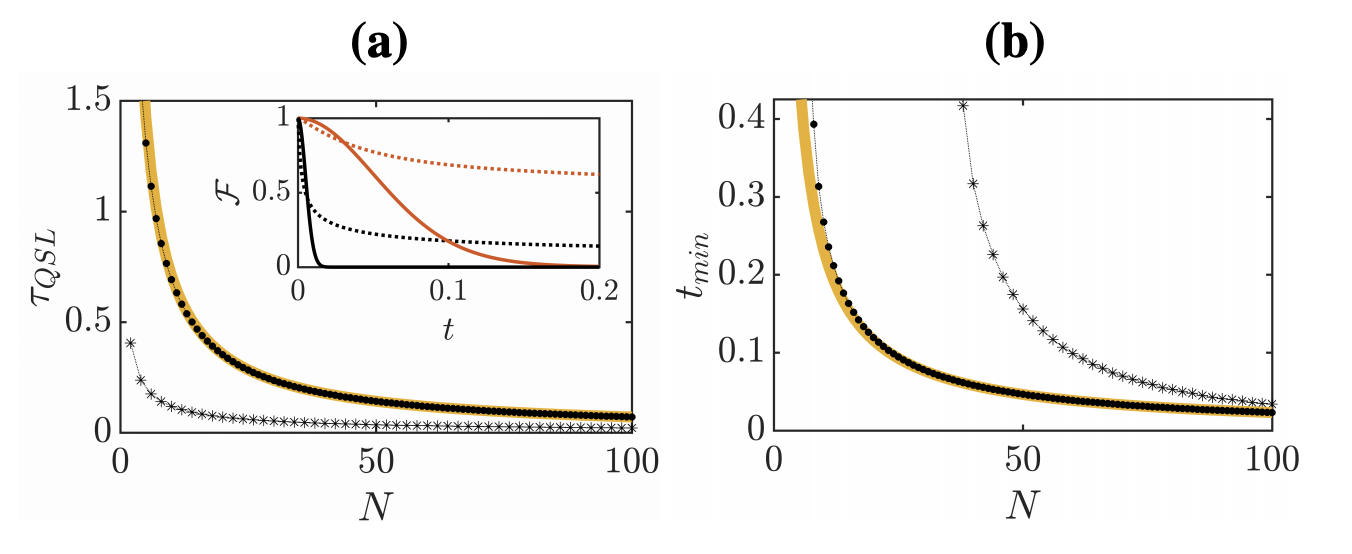
Figure: (a) Dots: QSL time as a function of particle number for a trap-quench. The yellow line uses an approximate expression in the large particle limit. Stars: QSL time for an impurity quench. Inset: Survival probability vs. time for 10 particles (red lines) and 100 particles (black lines) for a trap quench (solid lines) and an impurity quench (dotted lines). (b) Minimum time to reach a very low survival probability of 10-2 for the trap quench (dots) with the approximation given in the paper (yellow line), and minimum time to reach a survival probability of 0.25 for the impurity quench (stars).
4.1 Journal Publications
- Quench Dynamics and Orthogonality Catastrophe of Bose Polarons
S.I. Mistakidis, G.C. Katsimiga, G.M. Koutentakis, Th. Busch, and P. Schmelcher
Phys. Rev. Lett. 122, 183001 (2019) - Chaotic few-body vortex dynamics in rotating Bose-Einstein condensates
Tiantian Zhang, James Schloss, Andreas Thomasen, Lee James O'Riordan, Thomas Busch, and Angela White
Phys. Rev. Fluids 4, 054701 (2019) - Torque of guided light on an atom near an optical nanofiber
F. Le Kien and Th. Busch
Opt. Exp. 27, 15046 (2019) - Roadmap on STIRAP applications
Klaas Bergmann et al.
J. Phys. B: At. Mol. Opt. Phys. 52, 202001 (2019). - Driving Interactions Efficiently in a Composite Few-Body System
Alan Kahan, Thomás Fogarty, Jing Li and Thomas Busch
Universe 5, 207 (2019) - Coupled density-spin Bose-Einstein condensates dynamics and collapse in systems with quintic nonlinearity
Jing Li, Boris A. Malomed, Wenliang Li, Xi Chen, and E. Ya Sherman,
Commun. Nonlinear. Sci. Numer. Simulat. 82, 105045 (2020) - Waveguide-induced dispersion interaction between two two-level atoms with orthogonal in-transverse-plane dipoles
F. Le Kien, L. Ruks, and Th. Busch,
Appl. Phys. B 125, 205 (2019) - Graded-index optical fiber emulator of an interacting three-atom system: illumination control of particle statistics and classical non-separability
M.A. Garcia-March, N.L. Harshman, H. da Silva, T. Fogarty, Th. Busch, M. Lewenstein, and A. Ferrando
Quantum 3, 210 (2019) - Spin-orbit coupling in the presence of strong atomic correlations
A. Usui, T. Fogarty, S. Campbell, S.A. Gardiner, and Th. Busch
New J. Phys. 22, 013050 (2020). - Light-induced rotation of dielectric microparticles around an optical nanofiber
G Tkachenko, I Toftul, C Esporlas, A Maimaiti, F Le Kien, VG Truong and S Nic Chormaic
Optica 7, 59 (2020). - Many-body quantum dynamics and induced correlations of Bose polarons
S. Mistakidis, G. Koutentakis, G. Katsimiga, Th. Busch, and P. Schmelcher
New. J. Phys. 22, 043007 (2020) - Orthogonality Catastrophe as a Consequence of the Quantum Speed Limit
T. Fogarty, S. Deffner, Th. Busch, and S. Campbell
Phys. Rev. Lett. 124, 110601 (2020)
4.2 Books and other one-time publications
Nothing to report
4.3 Oral and Poster Presentations
4.3.1 Conference Invited Talk
- Busch, Th. Simulating interacting three atoms systems in optical fibres: Control of particle statistics and classical entanglement, Compound (Atomic) Quantum Systems, Leiden, Netherlands (20 May 2019).
- Busch, Th. Quench dynamics and orthogonality catastrophe in strongly correlated multi-component gases, Workshop on Quantum Mixtures, Trento, Italy (15 July 2019)
- Busch, Th. Controlling interacting few-body systems, Japan-Netherlands Quantum Conference, Delft, Netherlands (17 September 2019).
- Busch, Th. Controlling interacting few-body systems, Quantum Technologies: Academia Meets Industry, Shanghai, China (21 September 2019)
- Li, J. Efficient interaction control in few-body systems, 2020 International Workshop on Quantum Information, Quantum Computing and Quantum Control, Shanghai University (3 January 2020).
4.3.2 Conference Oral Presentation
- Polo Gomez, J. Oscillations and decay of superfluid currents in a one-dimensional Bose gas on a ring, Atomtronics 2019, Benasque, Spain (13 May 2019).
- Fogarty, T. Controlling interacting quantum systems, Okinawa School in Physics: Coherent Quantum Dynamic, OIST, Okinawa, Japan (2 October 2019).
- Gietka, K. Cavity-based non-destructive measurements, Quantum Optics 2020, Obergurgl, Tirol, Austria (28 February 2020).
4.3.3 Conference Poster Presentation
- Chojnacki, L., Reshodko, I. & Busch, T. Topological edge states in a Finite Kronig-Penny model, New Trends in Complex Quantum System Dynamics, Venetian Institute of Science, Letters and Arts, Palazzo Franchetti. (11 April 2019).
- A. Usui, Interaction-induced symmetric-anti- symmetric transitions in two ultracold spin-orbit-coupledatoms, New Trends in Complex Quantum System Dynamics, Venetian Institute of Science, Letters and Arts, Palazzo Franchetti. (11 April 2019)
- Ruks, L., Le Kien, F. & Busch, T. Nanofiber-mediated optical binding between atoms, Light Matter Interaction in Dilute Media and Individual Quantum Systems, Les houches, France (17 April 2019).
- Chojnacki, L., Reshodko, I. & Busch, T. Topological edge states in a Finite Kronig-Penny mode, Atomtronics 2019, Benasque, Spain (7 &12 May 2019).
- Sachdeva, R., Metz, F., Singh, M., Mishra, T. & Busch, T. Two-leg-ladder Bose-Hubbard model with staggered fluxes, Synthetic Topological Matter, Max Planck Institute for the Physics of Complex Systems, Dresden, Germany (21 May 2019).
- Ruks, L., Le Kien, F. & Busch, T. Nanofiber-mediated optical binding between atoms, Optical Nanofibre Applications: From Quantum to Bio Technologies (ONNA2019), OIST, Okinawa (3-6 June 2019).
- Reshodko, I., Benseny, A., Romhányi, J., Chojnacki, L. and Busch, T., Topological states for ultracold atoms in the Kronig–Penney model with arbitrary scattering potentials, Bose-Einstein Condensation 2019, San Feliu, Spain (9 September 2019)
- Chojnacki, L., Reshodko, I. & Busch, T. Topological edge states in a Finite Kronig-Penney model, Okinawa School in Physics: Coherent Quantum Dynamic, OIST. Okinawa, Japan (24 September - 3 October 2019).
- Hasan, M. S., Polo Gomez, J. & Busch, T. Impurities in spin-orbit coupled Bose-Einstein condensates, Okinawa School in Physics: Coherent Quantum Dynamic, OIST, Okinawa, Japan (24 September - 3 October 2019).
- Keller, T., Fogarty, T. & Busch, T. An efficient nonlinear Feshbach engine, Okinawa School in Physics: Coherent Quantum Dynamic, OIST, Okinawa, Japan (24 September - 3 October 2019).
- Polo Gomez, J., Dubessy, R., Pedri, P., Perrin, H. & Minguzzi, A. Oscillations and decay of superfluid currents in a one-dimensional Bose gas on a ring, Okinawa School in Physics: Coherent Quantum Dynamic, OIST, Okinawa, Japan (24 September - 3 October 2019).
- Sachdeva, R., Metz, F., Singh, M., Mishra, T. & Busch, T. Two-leg-ladder Bose-Hubbard model with staggered fluxes, Okinawa School in Physics: Coherent Quantum Dynamic, OIST, Okinawa, Japan (24 September - 3 October 2019).
- Usui, A., Fogarty, T., Campbell, S., Gardiner, S. A. & Busch, T. Spin-orbit coupling in the presence of strong atomic correlations, Quantum Optics 2020, Obergurgl, Tirol, Austria (27 February 2020).
4.3.4 Seminar
- Busch, T. Simulating interacting three atoms systems in optical fibres: Control of particle statistics and classical entanglement, Trinity College Dublin, Dublin, Ireland, 14 May 2019.
- Usui, A. Interaction-induced momentum transition in two ultracold spin-orbit-coupled atoms, Max Planck Institute for the Science of Light, Erlangen, Germany, 9 July 2019.
- Busch, Th. Topological states in the Kronig-Penney model with arbitrary scattering potentials, Innsbruck University, Austria, 11 July 2019.
- Busch, Th. Topological states in the Kronig-Penney model with arbitrary scattering potentials, ENS de Lyon, France, 22 August 2019.
- Chojnacki, L. Topological states in the Arbitrary Finite Kronig-Penney mode, Universitat Autònoma de Barcelona, Spain, 14 October 2019.
- Usui, A. Exploration of Quantum States with Cold Atoms, IQOQI - Vienna, Austria, 21 October 2019.
- Li, J. Controlling interacting in few-body systems, Lund University, Switzerland, 25 November 2019.
5. Intellectual Property Rights and Other Specific Achievements
Nothing to report
6. Seminar, Meetings and Events
6.1 Seminar
6.1.1 Noise-stabilised particle transport and exotic-state preparation via shortcuts to adiabaticity
- Date: 29 May 2019
- Venue: OIST Campus Center Building
- Speaker: Andreas Ruschhaupt (Lecturer, University College Cork, Ireland)
6.1.2 Quantum integrated technologies
- Date: 9 July 2019
- Venue: OIST Campus Center Building
- Speaker: Jason Twamley (Professor, Macquarie University, Australia)
6.1.3 Decoherence and preparation of macroscopic quantum superposition in cavity QED
- Date: 22 July 2019
- Venue: OIST Campus Lab 1
- Speaker: Li Zheng (Professor, Dalian Polytechnic University, China)
6.1.4 Quantum droplet formation and dynamics in a one-dimensional dipolar ferrofluid
- Date: 15 October 2019
- Venue: OIST Campus Lab 1
- Speaker: Matthew Edmonds (Postdoc, Keio University, Japan)
6.1.5 Transport and eigenstate thermalisation in manybody physics
- Date: 3 December 2019
- Venue: OIST Campus Lab 1
- Speaker: John Goold (Assistant Professor, Trinity College Dublin, Ireland)
6.1.6 A spin heat engine coupled to a harmonic-oscillator flywheel
- Date: 4 December 2019
- Venue: OIST Campus Lab 1
- Speaker: Mark Mitchison (Postdoctoral Researcher, Trinity College Dublin, Ireland)
6.1.7 Comparing the cost of quantum control
- Date: 30 January 2020
- Venue: OIST Campus Lab 1
- Speaker: Steve Campbell (Assistant Professor, University College Dublin, Ireland)
6.1.8 Stirred Bose-Einstein condensates on 1D rings: spectrum and adiabatic excitation
- Date: 02 Mar 2020
- Venue: OIST Campus Lab 1
- Speaker: Axel Pérez-Obiol (Postdoc, Kochi University of Technology, Japan)
6.2 Meetings and Events
6.2.1 Okinawa School in Physics 2019: Coherent Quantum Dynamics (CQD2019)
- Date: September 24 - October 3, 2019
- Venue: OIST Seaside House
- Organizers:
- Thomas Busch OIST Graduate University: Organising and Programme Committee
- Síle Nic Chormaic OIST Graduate University: Organising and Programme Committee
- Yasunobu Nakamura The University of Tokyo: Programme Committee
- Yoshiro Takahashi Kyoto University: Programme Committee
*16 - 20 March Information Security in Quantum Age has been postponed due to the COVID-19 outbreak
7. Other
Nothing to report.



